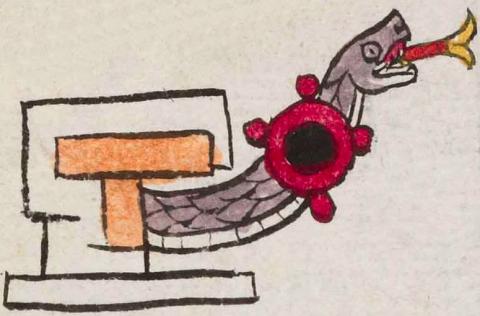Tezcacoac (Mdz20v)
This compound glyph for the place name Tezcacoac (perhaps "At the Mirror-Serpent") includes a building or house (calli), which does not play a phonetic role here, but may be a semantic locative. The glyph also has a purplish-gray, scaly serpent (coatl) with a white belly. The serpent, with its red and yellow, bifurcated tongue, is emerging from the building, in the direction of the viewer's right. On the serpent is a mirror (tezcatl), a circle of red with a black center and four evenly-spaced small red circles around the circumference.
Stephanie Wood
The locative suffix -c is not shown visually, but the house, which is visual but silent, serves something like a locative and therefore probably what Gordon Whittaker would call a "semantic complement."
The association between mirrors and serpents calls to fore the possibility of a supernatural reading. The nahualtezcatl, which was a mirror for divining, may tie in with this.
Stephanie Wood
tezcacoac. puo
Tezcacoac, pueblo
Stephanie Wood
c. 1541, or by 1553 at the latest
Stephanie Wood
snakes, serpents, mirrors, buildings, serpientes, espejos, cohuatl, nombres de lugares

tezca(tl), mirror, https://nahuatl.wired-humanities.org/content/tezcatl
coa(tl), snake or serpent, https://nahuatl.wired-humanities.org/content/coatl
-c (locative suffix), https://nahuatl.wired-humanities.org/content/c
nahualtezca(tl), a mirror used for divining, https://nahuatl.wired-humanities.org/content/nahualtezcatl
Codex Mendoza, folio 20 verso, https://digital.bodleian.ox.ac.uk/objects/2fea788e-2aa2-4f08-b6d9-648c00..., image 51 of 188.
The Bodleian Libraries, University of Oxford, hold the original manuscript, the MS. Arch. Selden. A. 1. This image is published here under the UK Creative Commons, “Attribution-NonCommercial-ShareAlike 3.0 License” (CC-BY-NC-SA 3.0).







